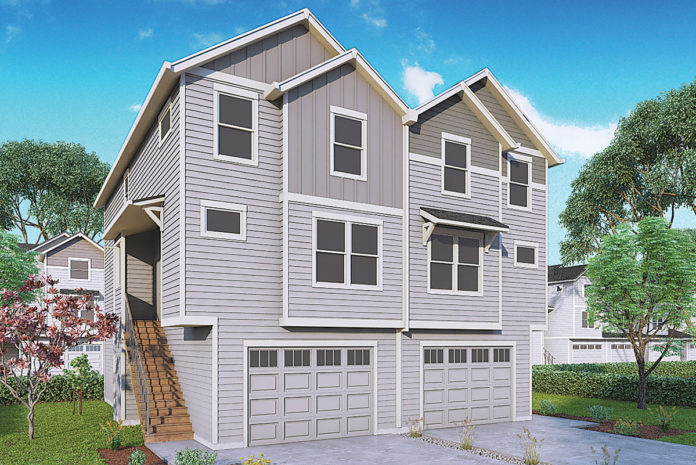Clark County’s real estate market had a brisk spring, with more inventory coming online and more sales – along with a slowdown in spiking prices.
In May, the most recent month with available statistics, 904 new pending residential sales were listed with the Regional Multi Listing Service, up 6.9% from a strong April and up 2.3% from May 2018. Still, it didn’t set a record. Overall May’s listings were down 7.7% from May 2017, but better than any other May since 2005. Listing activity also improved dramatically in May, with the second-best listing activity for the month in a decade with 1,272 new listings submitted, and also an 11.6% jump from April. That’s good news, said Mike Lamb, a real estate broker with Windermere Stellar, because it means the market is normalizing a bit.
“Historically, we should be doing more than 1,000 listings a month,” Lamb said. “For several years we were not doing anything close to that – and this year we have been.”
The start of the year was a bit of a mixed bag, Lamb said. January was a strong month, but a snowy February slowed things down.
“It’s better than I expected last fall,” Lamb said. “January was a surprise – we came out of the gate real fast. Then we had weather in February, which slowed us down. But we’ve had a terrific year so far.”
Average home prices increased a little in May, as they did in April, but not nearly as quickly as they have in recent years. The average sale price for homes across the Multi Listing Service was $395,444 in May, up 2.8% from May 2018, and 15.3% from May 2017. The median sales price was $375,000, up 4.2% from May 2018 and 15.4% from May 2017.
“Prices are stagnating, or having slower appreciation rates due to increased inventory,” said Terry Wollam, owner of Wollam and Associates in Clark County, which is part of Remax. “Sales activity is very similar to years prior. There’s a little more inventory and that’s helping to temper the increase in values. So, it’s not as aggressive as we’ve seen in years past.”
That slowing of rising costs, coupled with the increase in listing activity, is starting to loosen the market up a bit, which means some people who have been waiting a long time to move are finally starting to consider it, Lamb said.
“People are finally starting to feel like they can move, so that’s freeing inventory,” Lamb said. “There could be a pent-up aspect to that as well. We have a bunch of Baby Boomers that are thinking about resizing. I don’t see them getting smaller houses, but I see them getting different housing.”
Boomers are generally looking for single-level living, ranch-style houses. There’s some construction going on anticipating their needs, but there’s a lot more demand than there is stock, Lamb said.
“The small lots we’re creating in the county don’t accommodate those kinds of housing, and that’s a problem,” Lamb said. “Ranch-style housing was about 50% of the housing here until around 1990-1991, when the average lot size got much smaller. Now there’s not a lot of ranch-style housing built anymore.”
Boomers tend to be looking for 1,700-square-feet or larger single-story homes with a three-car garage, yard and driveway, which ends up requiring about a 5,500-square-foot lot. And that sort of stock is very hard to come by in Clark County.
“There’s an awful lot of lots that aren’t that big,” Lamb said. “But the demand is there.”
The bulk of the inventory in Clark County is two-story homes, and the main market for those homes is Gen-Xers and Millennials. But first-time home buyers are still having problems reaching the high costs of home ownership.
“It’s become really challenging for them to afford this market,” Lamb said. “We’re still selling to first-time home buyers. But every time the prices go up, you drop people out of the market.”
Even if prices are still high, Vancouver and Clark County didn’t end up with the massive housing cost spikes seen in Seattle and Portland in recent years. Those big markets are starting to correct now, but Vancouver is unlikely to have the same issues that those two big cities are facing with market corrections because our growth didn’t get to that level, Lamb said.
“This market does not move in tandem with Portland,” Lamb said. “It never has. Sometimes the pricing is more, sometimes it’s less.”
So far, the rest of the year looks like it will follow typical real estate market patterns, Wollam said. Activity has seemed to slow somewhat in June, which is similar to what happened in June 2018.
“Historically, we see a slowdown in May trending into June, which matches the figures prior,” Wollam said. “Last June and this June were slower than normal.”
The general trend is that activity picks up in early July as the summer gets into full gear, with a peak in the third week or so. Then a slowdown in August when students return to school, followed by another uptick in activity in September, he said.
Overall, though, Lamb said he thinks the market is starting to stabilize and transform a bit from the red-hot pace of the past few years.
“In my opinion we’re starting to see the market normalize,” Lamb said. “There’s a little more inventory, a little slower pace of increase in price. We’re still on the extreme early end of that. But at least the trend is going in that direction.”




